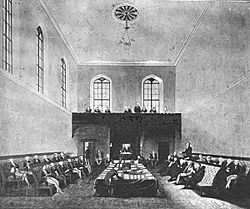Parliament of New South Wales facts for kids
Quick facts for kids Parliament of New South Wales |
|
|---|---|
| 57th Parliament | |
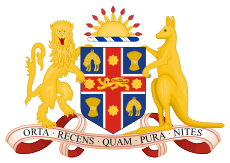 |
|
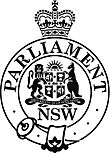 |
|
| Type | |
| Type | |
| Houses | Legislative Council Legislative Assembly |
| History | |
| Founded | 22 May 1856 |
|
New session started
|
7 May 2019 |
| Leadership | |
|
Elizabeth II
Since 6 February 1952 |
|
|
Margaret Beazley
Since 2 May 2019 |
|
|
Speaker of the Legislative Assembly
|
Jonathan O'Dea, Liberal
Since 7 May 2019 |
|
President of the Legislative Council
|
Matthew Mason-Cox, Liberal
Since 4 May 2021 |
|
Dominic Perrottet, Liberal
Since 5 October 2021 |
|
|
Leader of the Opposition
|
Chris Minns, Labor
Since 4 June 2021 |
| Structure | |
| Seats | 135 (93 MLAs, 42 MLCs) |
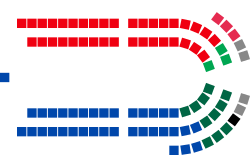 |
|
|
Legislative Assembly political groups
|
Government (45)
Opposition (37)
Crossbench (11)
|
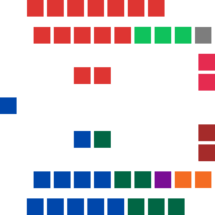 |
|
|
Legislative Council political groups
|
Government (17)
Opposition (14)
Crossbench (11)
|
| Elections | |
| Optional preferential voting | |
| Single transferable vote | |
|
Last general election
|
23 March 2019 |
|
Next general election
|
25 March 2023 |
| Meeting place | |
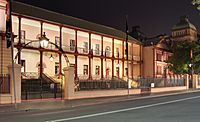 |
|
| Parliament House, Sydney, New South Wales, Australia |
|
| Constitution | |
| Constitution of New South Wales | |
The Parliament of New South Wales is like the main law-making group for the Australian state of New South Wales (NSW). It has two parts: the New South Wales Legislative Assembly (the 'lower house') and the New South Wales Legislative Council (the 'upper house'). People in New South Wales vote for members of both houses in elections held about every four years.
The Parliament gets its power from the Queen of Australia, Queen Elizabeth II. The Governor of New South Wales represents the Queen and helps lead the government's main council. The NSW Parliament works with the Australian Federal Parliament to make laws. It follows many old traditions from the British Parliament, like special clothing and chamber colours.
The Parliament building is located in Parliament House on Macquarie Street in Sydney.
Contents
History of the NSW Parliament
The Parliament of New South Wales is the oldest law-making body in Australia. It started when New South Wales was a British colony. Back then, the Governor was in charge.
Early Beginnings (1824-1856)
In 1824, a small group called the Legislative Council began meeting. Their job was to give advice to the Governor about new laws. By 1843, this group grew, and some of its members were elected. Only adult men who owned certain property could vote.
In 1856, a new set of rules, called a Constitution, changed everything. The Parliament became 'bicameral', meaning it had two houses. The New South Wales Legislative Assembly was fully elected by the people. The New South Wales Legislative Council had members chosen by the Governor. This new Parliament took over most of the law-making from the Governor. In 1858, all adult men in NSW gained the right to vote.
Becoming Self-Governing (1850s)
In 1850, a law from the British Parliament made the NSW Legislative Council even bigger. By 1851, it had 54 members, with two-thirds of them elected. In 1853, a special group started writing a Constitution for NSW to govern itself. This plan was mostly accepted.
The new Constitution, which included an upper house with members chosen for life, became law in 1855. The new Parliament of New South Wales would have two houses, just like the Parliament in the United Kingdom. On May 22, 1856, the new NSW Parliament opened and met for the first time. A second meeting room had to be built for the upper house.
Changes Over Time (1859-Present)
In 1859, Queensland became a separate colony from New South Wales. This meant the Legislative Assembly lost some members. In 1901, New South Wales became a state of the Commonwealth of Australia. Many government jobs moved to the new Commonwealth government. The current Constitution of New South Wales was put in place in 1902.
Women gained the right to vote in Australian elections in April 1902. They could vote in New South Wales state elections in August 1902. In 1918, women were allowed to become Members of Parliament. However, the first woman, Millicent Preston-Stanley, was not elected until 1925. Women could not be chosen for the Legislative Council until 1926.
Over the years, there were attempts to change or even get rid of the Legislative Council. In 1933, the law changed so that some members of the Legislative Council were elected by other politicians, not just chosen by the Governor. In 1962, Indigenous Australians gained the right to vote in all state elections. In 1978, the Legislative Council became a body directly elected by the people. Its size was also reduced. Further changes in 1991 made the Legislative Council 42 members, with half elected every four years. The Legislative Assembly also became smaller, with 93 members by 1999.
Parliament House Building
The Parliament building was first built as Sydney's second major hospital. Governor Lachlan Macquarie ordered its construction in 1810. The builders were paid with the right to import and sell a large amount of rum. This led to the building being known as the 'Rum Hospital'.
Original Hospital Buildings
The original hospital had three buildings. The main central building was pulled down in 1879 to make way for the new Sydney Hospital. This new hospital was finished in 1885. The first building of the old hospital is now called the Sydney Mint. It was used as a mint (where coins are made) from 1851 until 1927.
Becoming Parliament House
The second building, which was originally the Chief Surgeon's living quarters, was given to the government in 1829. It became the Parliament chamber. This chamber was made bigger as the Parliament grew in 1843 and again in 1856. The last big update to the building happened between 1974 and 1985. Old buildings were replaced with a new 12-story block. This new part is connected to the original Parliament House, which was restored to look like it did in 1908.
How Parliament Works
The power to make laws in NSW comes from three parts working together. These are the Queen (represented by the Governor), the Legislative Assembly, and the Legislative Council. A person cannot be a member of both houses at the same time.
Electing Members
All 93 members of the Legislative Assembly are elected at each general election. They represent specific areas, and their terms last up to four years. The 42 members of the Legislative Council are elected for two terms, which means up to eight years. Half of them are elected at each general election. People vote for Legislative Council members from across the whole state.
Leaders of Parliament
The two main leaders of Parliament are like ministers who run departments. The Speaker of the Legislative Assembly and the President of the Legislative Council are in charge of hiring staff. They also work with clerks to decide how their parts of Parliament will operate.
Making Laws and Government Power
For a new law (called a bill) to become official, it needs to be approved by both the Legislative Council and the Legislative Assembly. Then, the Governor must give it 'Royal Assent'. This means the Governor officially agrees to it.
The Governor also has special powers that don't need Parliament's approval. These include ending Parliament sessions, making agreements, giving awards, and choosing the Premier. In practice, the Governor always uses these powers based on the advice of the Premier and other government ministers. The Premier and the government must answer to Parliament and the public.
The Governor chooses the Premier, who is usually the leader of the political party that wins the most seats in the Legislative Assembly. The Premier then forms a government from members of Parliament. This person must have the support of most members in the Legislative Assembly.
The current Premier of New South Wales is Dominic Perrottet MP from the Liberal Party.
Government ministers, including the Premier, regularly answer questions in Parliament. There are also special committees that look closely at specific issues and how the government is working. Members of Parliament can also bring up issues that affect the people they represent.
Parliament Traditions
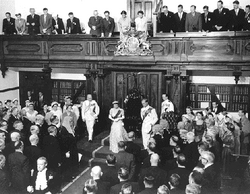
The State Opening of Parliament is a yearly event that marks the start of a new Parliament session. It takes place in the Legislative Council Chamber, usually in November or December. If there has been a general election, it happens when the new Parliament first meets. It is a very formal event with lots of ceremony and important people attending. The New South Wales Parliament keeps many traditions from the original Parliament of the United Kingdom.
The Governor's Speech
The Governor, or sometimes even the monarch, reads a special speech. This speech is called the Speech from the Throne. It explains what the government plans to do in the coming year. The government's ministers write this speech, not the Governor. It shows the laws they want both houses of Parliament to agree on.
Queen Elizabeth II has opened the New South Wales Parliament two times. The first time was on February 4, 1954. This was part of her first visit to Australia. It was also the first time the Queen of Australia had opened any Australian Parliament. She opened it again on February 20, 1992. This was during her visit to Sydney to celebrate 150 years since Sydney became a city.
Parliament Emblem
The official symbol of the Parliament is a special crown with the Coat of Arms of New South Wales inside a circle. This design is similar to a Scottish 'crest badge'. Crest badges are not very old. They became popular in the mid-1800s.
The crest badge became the symbol for both houses of Parliament in the mid-1900s. You can see this emblem on official papers, books, and even on items used in Parliament, like cutlery and china.


